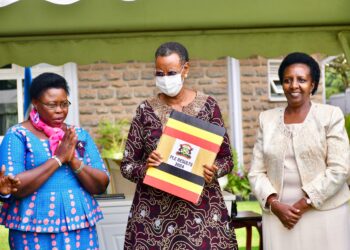In 2013, Ministry of Education reports indicated that 1,875,553 children enrolled for Primary one in Uganda. After seven years on the educational conveyer belt, only 736,942 were able to sit Primary Leaving Exams in 2020 when this cohort should have popped out of the first stage of our education pipeline. Unsettlingly, these statistics are not the exception, they have become a permanent fixture in our education statistics.
Every seven-year, one-half of the children that join primary school disappear without a trace. There is a Bermuda triangle of sorts, that is vacuuming clean our potential human resource. This tragedy should be an invitation for us to interrogate where these children are going. Most importantly, we need to question whether these children are ‘dropping out’ or are being ‘kicked out’ of school. The pull, push and fall out factors need to be fully examined.
After the release of PLE results, in what has become a permanent feature in our news around this time of the year, newspapers publish screaming headlines coached in pomp and ceremony- to the delight of parents from the middle-class tier. Tragically, the angling of the news on PLE results often veils the tragedy that these results have come to represent. The fact that out of 1.8 million children, only 700,000 complete Primary seven does not unsettle us should be the news- But it is not. But what is going on? At what point are we losing these children? Who are they?
In my view, it would be interesting for the Ministry of Education and Sports to develop an Early Warning System with enough antennas across all classes to flag to the responsible authorities, children at risk, who are about to drop out of school so that strategies and interventions that address their special needs are mounted to halt this sickening hemorrhage.
While the factors that lead to the disappearance of over a million children from school may be both complex and dynamic- ranging from the widespread deprivation and poverty of most households to the hegemonic architecture of our school system that alienates the learner from what should be a co-creating space, there is sufficient evidence that suggests that setting up an Early Warning System to identify students at risk of dropping out, based on a clear set of indicators or red flags can improve the design of response measures.
While there have been efforts to address both the demand and supply side of needs to keep children in school, efforts towards setting up and utilization of early warning systems that signal a red flag at the earliest opportunity – before children drop out of school, have not been adequate.
While it is a settled fact that certain indicators are a sure signal for drop out of school, I am yet to fully appreciate whether this information is being collected and used to inform educational programming. We know that while certain shifts in a child’s situation, especially external shocks, can lead to sudden dropout, in most cases, dropping out is a gradual process and most of the factors that mediate it are stable over time. They can be measured, observed, and disrupted.
Usually, children drop out or are kicked out of school after the layers of disadvantage have increased in intensity, been unattended to, making it almost impossible for the child to remain in school. In some studies, there is evidence to suggest that even when the pressures are extreme, it takes about three years for a student to finally cede to the pressure and drop out of school. Therefore, it is possible to observe and track these children at risk and mount responses both in and out of school, to keep them in school.
In many Ugandan schools, there is gradual withdraw from school. The disengagement whether orchestrated by factors at home or in the community or at school is often gradual, goes unnoticed and yet it can be observed. In almost all cases, dropping out is preceded by poor or low school attendance, low or poor academic performance, or poor or disruptive behavior.
You can almost predict with surgical accuracy who will drop out of school by keeping an eye on these three indicators. It would be interesting for the Ministry of Education and sports to develop a system to track these indicators and use the information to develop interventions to support the children.
For many households, once they establish that the cost of keeping the child in school outstrips rewards, and the child is having poor academic performance, which may also be due to factors related to little support they are getting, the family may withdraw the support to the child leading to a drop or fall out.
It is also my opinion that we need to keep an eye on children from extremely impoverished families and perhaps offer more assistance to them. For example, nearly 20% of Uganda’s population is living below the poverty line, 20% of parents should not be paying PLE or UCE registration fees. If it is an established fact that a family is indigent, why would you require that they pay money they cannot even afford to raise for their basic needs?
Imagine the government spends billions to keep the children in school for close to seven years, but then the child drops out because the parent can not afford the registration fees. Some parents should be freed from this burden. This will increase the number of children that complete P.7- at least those who drop out due to failure to raise the registration fees.
The poverty levels in Uganda almost correspond with the child labor figures. Families that are poor will employ their children in work that keeps them away from school, affects their academic performance- eventually leading to a child’s loss of interest in school due to poor performance or their fear of failing to catch up with peers.
If we were able to monitor students that are falling behind in performance, seem less engaged, have irregular attendance, are from ethnic minorities, have lost a parent, come from poor households, orphans, living with elderly, HIV+, PWD parents, are older than their peers, have a chronically disease or are sickly, we would get some answers. It is clear that certain proxies like low performance, poor attendance, and other behaviors in school—most of them inspired by the child’s experiences during and after school, can effectively predict school dropout.
By observing school performance, Low achievement, Repetition or being overage for a class, poor engagement at school, poor attendance, low educational expectations, low commitment to school or lack of interest in school, disruptive behavior/Misbehavior/delinquency, we are likely to nip it in the bud.
The design of the school system could be silently ‘excluding’ many learners with abandon. If in any way, were are able to know which students are attending less than 70% of scheduled class time, are two or more years overage for their grade; and are performing two or more years behind academically, especially in English and Arithmetic, and design appropriate support interventions, we would more than halve the number of children dropping out before completing Primary Seven.
Given that delivery of primary education is decentralized, there is urgent need to build the capacity of local governments to observe, monitor and support learners who present these characteristics. Knowing the number of days a child is absent in a month, particular the number of consecutive days a child is absent and the number of days the child is coming late or leaving early would provide timely information that can be used by educational programmers or policymakers to design interventions that respond to their needs in a timely manner.
While this information may be collected, it is not being used to respond to the needs of the learners. Teachers seem to be collecting information as part of their routine. They do not have the training needed to support the multicultural nature of the classroom and explore the experiences of their learners.
Whether the 1.8 million children starting primary one every year, finish the formal educational track or fall out of school, they will end up in the labour market. It is important that we complement formal education with other work-based learning schemes that can improve the employability of our youth. There are many youths joining the labour market without any qualifications or competencies. These youth may not fit within the formal vocational education framework and may need other forms of support to improve their employability and productivity.
It is very possible for Uganda to half the number of children dropping out of school if we develop systems to track at-risk children and design appropriate interventions to support them stay in school. We are burning a lot of money to have these children in school and there should be educational outcomes that justify these expense.
Do you have a story in your community or an opinion to share with us: Email us at editorial@watchdoguganda.com













